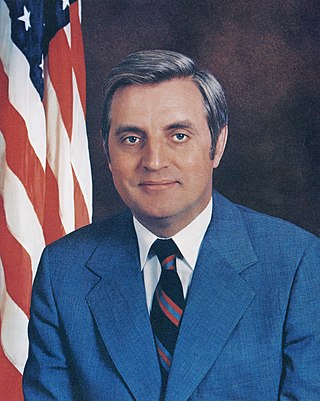
Walter Frederick "Fritz" Mondale was an American lawyer and politician who served as the 42nd vice president of the United States from 1977 to 1981 under President Jimmy Carter. A U.S. senator from Minnesota from 1964 to 1976, he was the Democratic Party's nominee in the 1984 presidential election, but lost to incumbent Ronald Reagan in an Electoral College and popular vote landslide.

The Minnesota Democratic–Farmer–Labor Party (DFL) is a political party in the U.S. state of Minnesota affiliated with the national Democratic Party. The party was formed by a merger between the Minnesota Democratic Party and the Minnesota Farmer–Labor Party in 1944. The DFL is one of two state Democratic Party affiliates with a different name from that of the national party, the other being the North Dakota Democratic–Nonpartisan League Party.

Albert Harold "Al" Quie was an American politician and farmer. Quie served as a member of the United States House of Representatives from 1958 to 1979 and as Governor of Minnesota from 1979 to 1983.

Karl Fritjof Rolvaag was an American diplomat and politician who served as the 31st governor of Minnesota from March 25, 1963, to January 2, 1967, as a member of the Democratic-Farmer-Labor (DFL) Party. He was the son of the author and professor Ole E. Rølvaag.

The Republican Party of Minnesota is the state affiliate of the Republican Party in Minnesota and the oldest active political party in the state. Founded in 1855, the party is headquartered in Edina, and the current chairman is David Hann.

The first modern Farmer–Labor Party in the United States emerged in Minnesota in 1918. The American entry into World War I caused agricultural prices and workers' wages to fall, while retail prices rose sharply during the war years. Consequently, farmers and workers made common cause in the political sphere to redress their grievances.
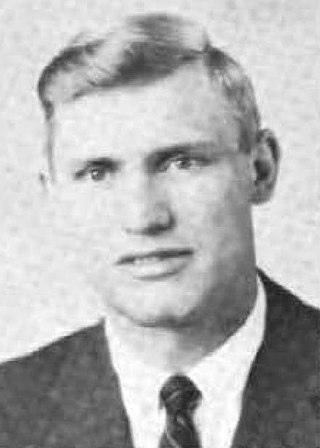
Alexander MacDonald "Sandy" Keith was an American politician and jurist who was the first person to hold office in each of the three branches of Minnesota state government, serving as state senator, the 37th Lieutenant Governor, and as an associate justice and later chief justice of the Minnesota Supreme Court.
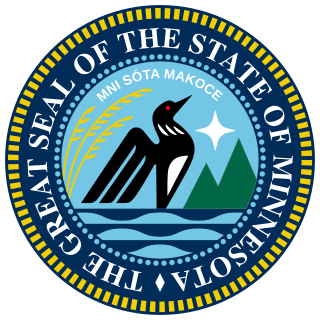
Minnesota is known for a politically active citizenry, with populism being a longstanding force among the state's political parties. Minnesota has consistently high voter turnout, ranking highest or near-highest in recent elections. This is due in part to its same-day voter registration laws; previously unregistered voters can register on election day, at their polls, with evidence of residency.
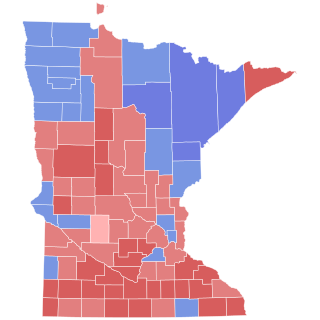
The 1966 Minnesota gubernatorial election took place on November 8, 1966. Republican Party of Minnesota challenger Harold LeVander defeated Minnesota Democratic–Farmer–Labor Party incumbent Karl Rolvaag. Sandy Keith unsuccessfully ran for the Democratic nomination.

Fred C. Norton was a Minnesota politician, a member of the Democratic-Farmer-Labor Party, a Speaker of the Minnesota House of Representatives, and a judge of the Minnesota Court of Appeals.

The 2014 Minnesota gubernatorial election took place on November 4, 2014, to elect the governor of Minnesota concurrently with the election to Minnesota's Class II U.S. Senate seat, as well as other elections to the United States Senate in other states and elections to the United States House of Representatives and various state and local elections.

The 1918 United States elections elected the 66th United States Congress, and took place in the middle of Democratic President Woodrow Wilson's second term. The election was held during the Fourth Party System. It was the lone election to take place during America's involvement in World War I. Republicans won control of both chambers of Congress for the first time since the 1908 election.
The 1998 Minnesota House of Representatives election was held in the U.S. state of Minnesota on November 3, 1998, to elect members to the House of Representatives of the 81st Minnesota Legislature. A primary election was held on September 15, 1998.
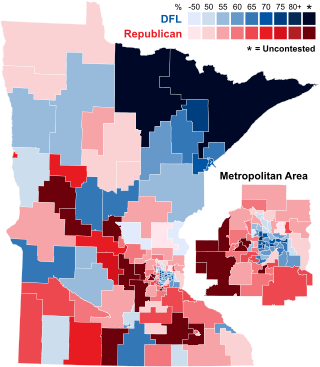
The 2000 Minnesota House of Representatives election was held in the U.S. state of Minnesota on November 7, 2000, to elect members to the House of Representatives of the 82nd Minnesota Legislature. A primary election was held on September 12, 2000.

The 2000 Minnesota Senate election was held in the U.S. state of Minnesota on November 7, 2000, to elect members to the Senate of the 82nd Minnesota Legislature. A primary election was held on September 12, 2000.

The 1976 Minnesota House of Representatives election was held in the U.S. state of Minnesota on November 2, 1976, to elect members to the House of Representatives of the 70th Minnesota Legislature. A primary election was held on September 14, 1976.
The 1980 Minnesota Senate election was held in the U.S. state of Minnesota on November 4, 1980, to elect members to the Senate of the 72nd Minnesota Legislature. A primary election was held on September 9, 1980.

The 1940 United States Senate election in Minnesota took place on November 5, 1940. Incumbent U.S. Senator Henrik Shipstead defected to the Republican Party of Minnesota from the Farmer–Labor Party of Minnesota, and defeated former Governor Elmer Benson of the Farmer–Labor Party and John E. Regan of the Minnesota Democratic Party to win a fourth term.

The 1942 United States Senate special election in Minnesota took place on November 3, 1942. The election was held to fill the vacancy in the seat formerly held by the late Ernest Lundeen for the final two months of Lundeen's unexpired term. Governor Harold Stassen had appointed Joseph H. Ball to fill the seat in 1940, but this appointment was temporary and subject to a special election held in the next general election year thereafter—1942. Ball opted to run for the full six-year term immediately following the end of Lundeen's term, instead of running for election to continue for the remainder of the term. In Ball's stead, the Republican Party of Minnesota nominated Arthur E. Nelson, who, in the special election, defeated both of his challengers—Al Hansen of the Farmer–Labor Party of Minnesota and John E. O'Rourke of the Minnesota Democratic Party.

The 1977 United States House of Representatives special election in Minnesota's 7th congressional district was held on February 22, 1977, to select the successor to Bob Bergland (DFL) who resigned to accept appointment as Secretary of Agriculture under the Carter Administration. Independent-Republican candidate Arlan Stangeland defeated the DFL favorite, Mike Sullivan, in an upset landslide.



















